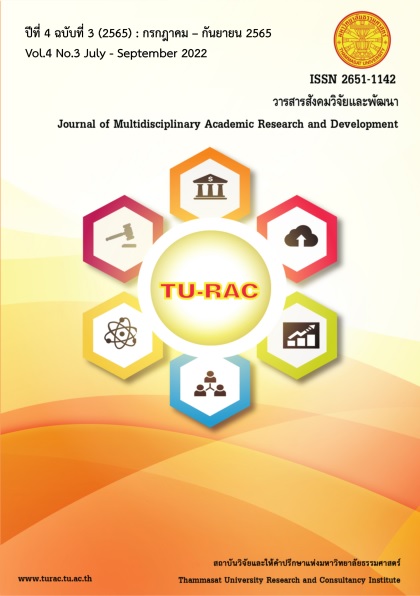Factors Affecting Distance Learning Success for Vocational Education Students in Chainat Province
Keywords:
Distance learning, Study success, Vocational students, FactorAbstract
The objectives of this research were to 1) study factors affecting distance learning success for vocational education students; and 2) construct a predictive equation for distance learning success of vocational education students. Exploratory research was done, with 369 samples, all vocational education students in Chainat Province during the second semester of academic year 2021. Data was collected by a 40-item questionnaire about three factors: students, teachers, and technology. A rating scale was characterized by specifying weighted five point Likert scale scoring. Data was analyzed by statistics, percentage, mean, standard deviation and stepwise multiple regression.
Results were that 1) technology influenced distance learning success most, with standard score regression coefficient (beta) (SSRCB) of 0.207 at a 0.05 level of statistical significance, followed by students with SSRCB of 0.163 at a 0.05 level of statistical significance, and teachers with SSRCB of 0.092 at a 0.05 level of statistical significance, in decreasing order of importance; and 2) students and technology combined predict distance learning success. Students and technology accounted for distance learning success variance of 3.5 percent (R2 = 0.035).
The best predictive equations affecting distance learning success in raw and standard scoring forms were as follows:
= 2.485 + 0.537X1 - 0.368X3
Z = 0.195X1 - 0.165X3
References
กองการวิจัยทางการศึกษา. (2556). การวิจัยเพื่อการพัฒนาการเรียนรู้ตามหลักสูตรการศึกษาขั้นพื้นฐาน. กรุงเทพฯ: กองการวิจัย.
กัลยา วานิชย์บัญชา. (2552). การใช้ SPSS for Windows ในการวิเคราะห์ข้อมูล. พิมพ์ครั้งที่ 6. กรุงเทพฯ: จุฬาลงกรณ์มหาวิทยาลัย.
จักรกฤษณ์ โพดาพล. (2563). การจัดการเรียนรู้ออนไลน์: วิถีที่เป็นไปทางการศึกษา. สืบค้นวันที่ 12 เมษายน 2565, จาก https://slc.mbu.ac.th/article/28181.
เฉลิมพล ทำงาน และ นภัส ไชยวงศ์. (2561). Google classroom นวัตกรรมการจัดการศึกษาในศตวรรษที่ 21.
นิรมล ชอุ่ม. (2563). ความสัมพันธ์ระหว่างการรู้เทคโนโลยีสารสนเทศและการสื่อสารกับผลสัมฤทธิ์ทางการเรียนของนักศึกษา มหาวิทยาลัยราชภัฏจันทรเกษม. Journal of Chandrakasemsarn. 26(2), 178-193.
พัศรินท์ ก่อเลิศวรพงศ์. (2559). การศึกษาแรงจูงใจใฝ่สัมฤทธิ์ของนักศึกษาคณะมนุษยศาสตร์และสังคมศาสตร์มหาวิทยาลัยราชภัฏสวนดุสิต. วารสารร่มพฤกษ์ มหาวิทยาลัยเกริก. 34(3), 35-54.
ภทรพร ยุทธาภรณ์พินิจ. (2559). การสังเคราะห์งานวิจัยเรื่อง การพัฒนาแรงจูงใจใฝ่สัมฤทธิ์ตามแนวคิดของ ป.อ. ปยุตโต. วารสารสังคมศาสตร์. 5(2), 55–69.
รุจิราพรรณ คงช่วย. (2557). รูปแบบความสัมพันธ์เชิงสาเหตุของปัจจัยที่มีอิทธิพลต่อผลสัมฤทธิ์ทางการเรียนของนักศึกษาคณะครุศาสตร์ มหาวิทยาลัยราชภัฏเขตภาคใต้ (รายงานการวิจัย). สงขลา: คณะครุศาสตร์มหาวิทยาลัยราชภัฏสงขลา.
วิมลมาศ ฟูบินทร์. (2557). การพัฒนาแบบวัดสภาพแวดล้อมเพื่อการเรียนรู้ในห้องเรียนระดับประถมศึกษา. (วิทยานิพนธ์ปริญญามหาบัณฑิต). มหาวิทยาลัยจุฬาลงกรณ์, กรุงเทพฯ.
ศลิษา เลี่ยมสุวรรณ. (2555). การเปรียบเทียบการรู้สารสนเทศและการรู้เทคโนโลยีสารสนเทศและการสื่อสารกับผลสัมฤทธิ์ทางการเรียนของนักศึกษามหาวิทยาลัย: กรณีศึกษานักศึกษาระดับปริญญาตรี มหาวิทยาลัยสงขลานครินทร์ วิทยาเขตปัตตานี (วิทยานิพนธ์ปริญญามหาบัณฑิต). มหาวิทยาลัยสงขลานครินทร์, สาขาการจัดการสารสนเทศ.
ศิวนิต อรรถวุฒิกุล, ประกอบ กรณีกิจ, และศยามน อินสะอาด. (2015). พฤติกรรมและปัจจัยที่ส่งผลต่อความสำเร็จในการจัดการเรียนการสอนแบบบูรณาการด้วยเทคโนโลยีสารสนเทศและการสื่อสารของครูในภูมิภาคตะวันตก. Silpakorn University Journal. 35(3), 1-21.
สมจิน เปียโคกสูง และ สุดารัตน์ น้อยมะโน. (2564). รายงานวิจัยสถาบันเรื่องปัจจัยที่มีผลต่อประสิทธิภาพในการจัดการเรียนการสอนผ่านระบบเทคโนโลยีสารสนเทศของมหาวิทยาลัยเทคโนโลยีสุรนารี กรณีสภาวการณ์ไม่ปกติ. สถานพัฒนาคณาจารย์ มหาวิทยาลัยเทคโนโลยีสุรนารี.
สิริพร อินทสนธิ์. (2563). โควิด-19: กับการเรียนการสอนออนไลน์ กรณีศึกษา รายวิชาการเขียนโปรแกรมเว็บ. วารสารวิทยาการจัดการปริทัศน์. 22(2), 203-213.
สุภาภรณ์ ตั้งดำเนินสวัสดิ์. (2558). ความสัมพันธ์ระหว่างพฤติกรรมการเรียนกับผลการเรียนรู้ตามกรอบมาตรฐานคุณวุฒิระดับอุดมศึกษาของนักศึกษารายวิชาภาษาอังกฤษเชิงสถานการณ์ ภาคการศึกษาที่ 2 ปีการศึกษา 2556. วารสารวิชาการบัณฑิตวิทยาลัยสวนดุสิต. 11(2), 223-230.
สำนักงานคณะกรรมการการอาชีวศึกษากระทรวงศึกษาธิการ. (2564). แนวทางการจัดการเรียนการสอนในสถานการณ์การแพร่ระบาดของโรคติดเชื้อไวรัสโคโรนา 2019 (COVID-19) ในสถานศึกษาสังกัดสำนักงานคณะกรรมการการอาชีวศึกษา. สืบค้นเมื่อวันที่ 10 เมษายน 2565, จาก https://www.vec.go.th/.
อติพร เกิดเรือง. (2560). การส่งเสริมการเรียนรู้ในศตวรรษที่ 21 เพื่อรองรับสังคมไทยในยุคดิจิทัล. Lampang Rajabhat University Journal. 6(1), 173-184.
อโรชา ทองลาว. (2564). การศึกษาความพึงพอใจของนิสิตมหาวิทยาลัยเกษตรศาสตร์ วิทยาเขตกำแพงแสน ต่อการจัดการเรียนการสอนรูปแบบออนไลน์ประจำภาคต้น ปีการศึกษา 2563. วารสารศิลปศาสตร์และอุตสาหกรรมบริการ. 4(2), 617-632.
Al-Ansi, A. M., & Al-Ansi, A. (2021). Future of Education Post Covid-19 Pandemic: Reviewing Changes in Learning Environments and Latest Trends. Solid State Technology. 63(6), 201584-201600.
Almarabeh, Hilal, Amer, Ehab, Sulieman, & Amjad. (2015). The effectiveness of multimedia learning tools in education. International Journal of Advanced Research in Computer Science and Software Engineering. 5(12), 761-764.
Amin, J. (2016). Redefining the Role of Teachers in the Digital Era. The International Journal of Indian Psychology. 3(3), 40-45.
Campillo - Ferrer, J. M., & Miralles - Martínez, P. (2021). Effectiveness of the Flipped Classroom Model on Students’ Self-Reported Motivation and Learning During the COVID-19 Pandemic. Humanities and Social Sciences Communications. 8(1), 176. doi: 10.1057/s41599-021-00860-4.
Cesco, S., Zara, V., Toni, A. F. D., & Lugli, P. (2021). Higher Education in the First Year of COVID - 19: Thoughts and Perspectives for the Future. International Journal of Higher Education, 10(3), 285-294. doi: 10.5430/ijhe. v10n3p285.
Kristine, P. (2007). 'm -Learning: Positioning educators for a mobile, connected future'. International Review of Research in Open and Distance Learning. 8(2), 2007 Retrieved from http://www. irrodl.org/.
Maphosa, C. & Bhebhe, S. (2019). Digital literacy: a must for open distance and e-learning (ODeL) students. European Journal of Education Studies. 5(10), 186-199.
Marek, M.W., Chew, C.S., & Wu, W.V. (2021). Teacher Experiences in Converting Classes to Distance Learning in the COVID-19 Pandemic. International Journal of Distance Education Technologies. 19(1), 89-109.
McClelland, D.C. (1953). The achievement motive. New York: Appleton-Century Crofts, Inc.
Pokhrel, S., & Chhetri, R. (2021). A Literature Review on Impact of COVID-19 Pandemic on Teaching and Learning. Higher Education for the Future. 8(1), 133-141. doi: 10.1177/2347631120983481.
Xie, X., Siau, K., & Nah, F. F.-H. (2020). COVID-19 Pandemic–Online Education in the New Normal and the Next Normal. Journal of Information Technology Case and Application Research. 22(3), 175-187. doi: 10.1080/15228053.2020.1824884.
Yamane, T. (1973). Statistics: An introductory analysis (3rd ed.). New York: Harper and Row.
Downloads
Published
How to Cite
Issue
Section
License
Copyright (c) 2022 ปอรยา สุวรรณสิทธิ์, น้ำทิพย์ องอาจวาณิชย์

This work is licensed under a Creative Commons Attribution-NonCommercial-NoDerivatives 4.0 International License.



